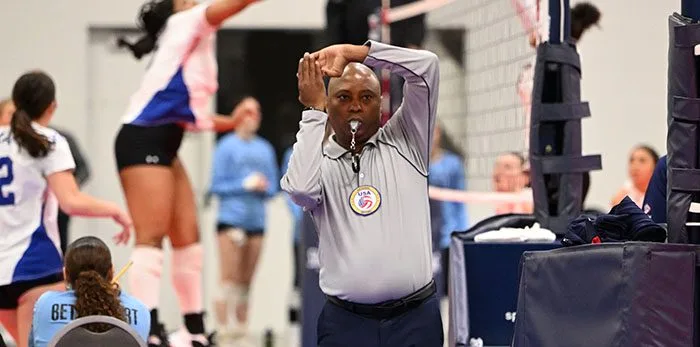Referee Signals Cheat Sheet for Players and Parents
Knowing referee signals is essential to understanding the game. This visual guide will help you recognize each signal and know how to respond appropriately.
📋 Guide Contents
🎯 Point and Service Signals
These are the most common signals you'll see during a match.
👉 Point for Team
Signal: Extended arm pointing to the side of the team that won the point
Meaning: The indicated team has won the point
How to Respond: If your team won: prepare to rotate if applicable. If you lost: return to your position quickly.
🏐 Authorization to Serve
Signal: Arm extended toward the team that will serve, sweeping motion toward service zone
Meaning: Authorization to perform the serve
How to Respond: Server has 8 seconds to serve after this signal.
🔄 Change of Courts
Signal: Arms extended in front of body making circular motion
Meaning: Teams must change sides of court
How to Respond: Change sides quickly. Occurs between sets and at point 8 of the 5th set.
⚠️ Violation Signals
These signals indicate a fault has been committed.
🚫 Four Hits
Signal: Four fingers extended upward
Meaning: Team touched the ball more than 3 times
How to Respond: Accept the decision. Mentally review the touch sequence to avoid repeating it.
👆 Double Contact
Signal: Two fingers extended
Meaning: A player touched the ball twice consecutively
How to Respond: If it was your fault, acknowledge it. Work on your technique to avoid doubles.
✋ Lift/Carry
Signal: Palm up, slow lifting motion
Meaning: Ball was held or carried instead of hit
How to Respond: Hit the ball more cleanly. Avoid "carrying" the ball.
📍 Position/Rotation
Signal: Finger circling in a circular motion
Meaning: Position or rotation error
How to Respond: Check your position before each serve. Talk with your team about rotations.
🌐 Net Touch
Signal: Indicating the net with hand
Meaning: A player touched the net during play
How to Respond: Be more careful at the net. Control your body when jumping and landing.
⏰ Delay
Signal: Hand signal covering the wrist
Meaning: Delay of game
How to Respond: Speed up the pace. Server has 8 seconds to serve.
🔀 Substitution Signals
🔄 Substitution Request
Signal: Circular motion of forearms around each other
Meaning: A substitution has been requested
How to Respond: Players involved must quickly approach the substitution zone.
🛡️ Libero Replacement
Signal: Arm movement in X shape
Meaning: Libero replacement
How to Respond: Libero and replaced player make the change. This doesn't count as regular substitution.
❌ Illegal Substitution
Signal: Arms crossed in front of chest
Meaning: Illegal substitution attempt (over limit or incorrect)
How to Respond: Substitution is not made. May result in penalty.
⏸️ Timeout Signals
⏱️ Timeout
Signal: Forming a "T" with hands
Meaning: Timeout requested (30 seconds)
How to Respond: Go to your bench quickly. Listen to coach instructions.
🔚 End of Timeout
Signal: Long whistle with gesture that time is over
Meaning: End of timeout
How to Respond: Return immediately to court. You have few seconds.
🎺 Technical Timeout
Signal: Gesture with open hand
Meaning: Automatic technical timeout (at points 8 and 16 of first 4 sets)
How to Respond: Brief pause. Take advantage to hydrate.
💡 How to Respond When You See These Signals
Beyond knowing the signals, it's important to know how to act when you see them.
For Players
- Stay calm: Don't argue with the referee. Their decisions are final.
- Learn from mistakes: If you commit a fault, understand why and avoid it.
- Communicate with your team: If there's confusion about rotation, talk with teammates.
- Maintain pace: Respond quickly to signals to maintain game flow.
- Watch the referee: Before each serve, look at the referee to make sure they're ready.
For Parents and Spectators
- Respect decisions: Referees are human and can make mistakes, but deserve respect.
- Don't yell at the referee: This only distracts players and creates negative environment.
- Use signals to understand the game: It will help you follow the match better.
- Cheer positively: Support your team without criticizing opponent or referee.
❓ Frequently Asked Questions
What does it mean when referee makes a "pushing" gesture?
The pushing gesture with hands forward indicates lift or carry of the ball. It means the player didn't hit the ball cleanly, but pushed or held it.
What's the difference between yellow and red card?
Yellow card: Warning for unsportsmanlike conduct. Red card: Penalty (point to opponent). Yellow + Red together: Set expulsion. Red alone second time: Match disqualification.
Why does referee point to one side then make another signal?
First indicates which team won the point (pointing to that side), then makes the specific signal of the fault committed or reason for the point.
Can a player ask for signal explanation?
Only the team captain can address the referee respectfully to ask for clarification during authorized breaks. No other player should interact with the referee.
🚀 Want to Learn More About Refereeing?
Discover everything about volleyball refereeing: functions, responsibilities and how to become a referee.
View Refereeing Guide
